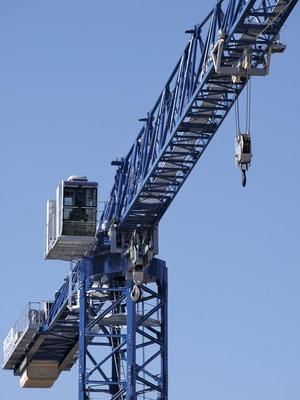
The latest revision to the American standard for tower cranes contains significant changes that affect how engineers should take into account wind loading on jobsites, including those prone to hurricanes. The standard also calls for more rigorous inspections than in the past, now requiring a major teardown and rebuild every five years.
Tower cranes now must be engineered to withstand wind conditions detailed in ASCE 7, the American Society of Civil Engineers' standard on minimum design loads for buildings and other structures; it was previously a recommendation. "The volume specifies that ASCE 7 wind speeds must be used for calculating foundations and freestanding heights," said Peter Juhren, corporate service manager for crane supplier Morrow Equipment Co. LLC, Salem, Ore., in a recent telephone interview. Juhren, who is also chairman of the tower-crane subcommittee for the ASME B30.3 standard published by the American Society of Mechanical Engineers, warned that even though the latest version was released in 2012, many people are still not aware of the changes.
Operationally, manufacturers and crane suppliers, such as rental companies, typically advise users on how to prepare for windy conditions, including hurricanes. Operators generally are advised to "weathervane" a tower crane, or unlock the swing brake, so its rotating structure can spin freely in the wind. According to the ASME B30.3-2012 document, the site supervisor and lift director are responsible for ensuring that weather or other adverse conditions are addressed in each lift.
Major inspections are, for the first time, also included in the new standard. The new inspection category calls for components such as drive systems, motors and gearboxes to be disassembled and, if necessary, rebuilt at 60-month intervals or as specified by the manufacturer. This practice, experts say, is important because some critical components are not visible during a crane's frequent (daily) or periodic (annual) inspection.
Like the wind standard, the major inspection aims to reduce risk by identifying potential failures. "As a committee, we felt that most of the maintenance issues on tower cranes, especially as they got older, were not keeping pace with the industry and what people in the industry were demanding for quality," noted Juhren during a Jan. 15 webinar hosted by the Specialized Carriers & Rigging Association.
Although it is not a requirement, the volume also recommends non-destructive testing of connection material, such as bolts and pins, during a major inspection. "If you are doing a five-year inspection, it is not a bad idea to do a non-destructive test of all the bolts," Juhren said.


Post a comment to this article
Report Abusive Comment